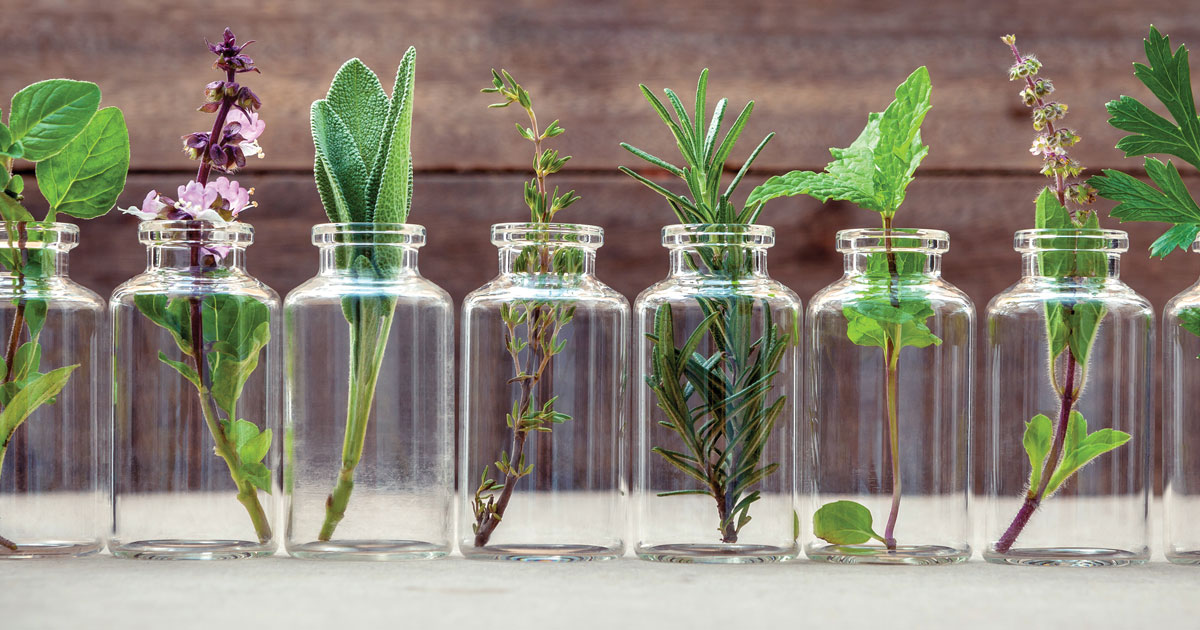Two steps away from the kitchen window is a means of supplementing homegrown health. The small pots containing your favorite herbs may be considered a flavoring to meals; yet, the reason why you enjoy garlic, for instance, is more than just taste. It has the propensity to lower cholesterol levels and prevent cancer. Today, an estimated 25% of all pharmaceuticals are derived directly from plants. Regardless of whether you have a green thumb or not, learning how herbs can boost your energy, improve circulation or memory is a step forward in maintaining a state of well-being.
Aloe Vera: Having an aloe plant on hand in a pinch can instantly help burns or infections as a topical medicine. While it contains powerful antioxidants, the aloe ingredient may be found in tablets or capsules to relieve indigestion, peptic ulcers, and inflammations.
Planting Tip: As a succulent, aloe vera thrives if planted in a cactus potting mix, perlite, or sand in a pot with plenty of holes for drainage. Similar tocacti, aloe vera is content in dry conditions.
Cilantro: While it has a unique flavor, cilantro is a powerful digestive aid that can remove heavy metals and toxic agents from the body.
Planting Tip: Thrives in colder temperatures. Plant after the last frost.
Garlic: Used thousands of years ago in Ancient Egypt, garlic was used as a flavoring and for health and therapeutic purposes including treating respiratory problems, parasites, poor digestion, and fatigue. Today, garlic is a remedy for conditions linked to the heart such as high cholesterol, heart attack, and hypertension. Garlic is also used to help prevent breast, colon, lung, prostate, and stomach cancers.
Planting Tip: Softneck garlic (the most common type found in grocery stores) is best if planted by October 15th; however, refrigerate bulbs below 40 degrees for at least two weeks before planting in the spring.
Ginger: Beyond flavoring your food, ginger is used to treat various types of stomach ailments such as morning sickness, nausea, gas, diarrhea, vomiting, or appetite loss. Additionally, it can help joint or muscle pain and fight the flu and common cold. Why not try drinking ginger tea?
Plating Tip: Growing ginger is not complicated, and is wonderfully aromatic. Get started by planting a ginger root in a pot and transfer after the last frost. Just remember, ginger plants take 10 months to mature.
Lavender: Usually planted as an eye-catching flower, the sweet aroma has a long history in medicinal medicine. With a long history dating 5,000 years ago, lavender was used to treat anxiety, depression, headaches, insomnia, and skin irritations. The least challenging herb to use, fresh lavender can be placed in a room. By merely inhaling, the fragrance can reduce stress and even mild pain. Topical use of lavender oil has improved skin conditions and balding spots.
Planting Tips: Best planted when the soil is warm in poor to moderately fertile soil. Add organic matter to improve drainage. Lavender does not thrive in wet, moist locations.
Lemon Balm:Even though the aroma is a lemony scent, the leaves are green. As a member of the mint family, lemon balm is an extraordinary herb with a list of benefits including stress and anxiety, memory and cognitive function, insomnia, indigestion and menstrual cramps, headache and nausea, and toothache. From dried leaves, lemon balm is gentle enough for children. Do not consume lemon balm for long periods of time.
Planting Tip: With shallow roots, lemon balm can grow an almost any soil. It should be contained in a pot to prevent spreading. Lemon balm can tolerate shade.
Peppermint: Easy to grow and will spread if not contained, peppermint can soothe symptoms of common illness such as a sore throat, headaches, or upset stomach. Peppermint added to tea can boost energy levels.
Journaling Your Wellness Experiences
Writing down your favorite recipes is a common endeavor; yet, have you ever recorded your experiences with herbs? You may discover a noted improvement such as a boost of energy when using peppermint or a way to ease a sore throat. Think about combining herbs such as steeping fresh peppermint and lemon balm leaves in hot water, and then adding honey. When you find great combinations, you’ll certainly want to remember them!






















